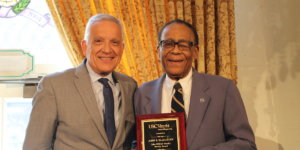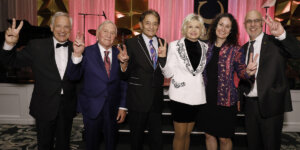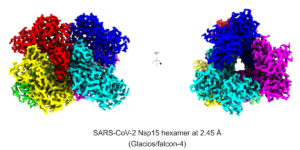
John D. O’Brien Nanofabrication Lab dedication with Marilyn O’Brien, Dean Yannis C, Yortsos and Marcy O’Brien/Photo: Dylan Cavaz
On Thursday, November 9th, 2017, family, friends, faculty and staff gathered to celebrate the naming of the John D. O’Brien Nanofabrication Lab dedicated to the beloved, former Executive Vice Dean of the USC Viterbi School of Engineering, who passed away unexpectedly last March. Over nearly a decade, O’Brien shepherded the project from initial conception to construction. He collaborated with administrators and faculty across departments and schools to design the state-of-the art facility inside the Michelson Center for Convergent Bioscience.
“The inauguration of Michelson Hall last week was probably one of the greatest days for USC Science and Engineering in our long history, spanning more than 100 years. But no dedication during my time at USC has ever meant more to me personally, than the John D. O’Brien Nanofabrication Lab, which will keep a lasting memory of John’s intellect, passion and vision,” said USC Viterbi School of Engineering Dean, Yannis C. Yortsos.
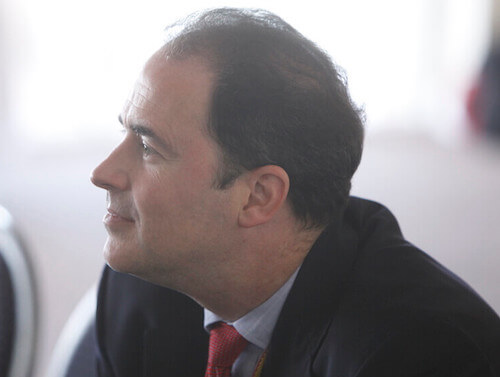
John O’Brien /Photo credit: Steve Cohn
“This facility would not have been possible without the strong financial support of $15M by an anonymous donor, whom I would like to deeply thank. It is situations like these, where philanthropy and vision happen to coincide with honoring remarkable human beings, that uplift us and fulfill us with humanity, gratitude and sense of purpose.”
Andrea Armani, the Ray Irani Chair in Engineering and Material Sciences and faculty member who will oversee the operations of the “Nanofab” explains that the Nanofab Lab and affiliated advanced cleanroom is essentially a “machine shop for nanotechnology, including all of the tools needed to fabricate and characterize structures and devices, of similar size to DNA and viruses, from a wide range of materials.” The nanofab is co-located in the Michelson Center with USC’s electron microscopy center and bioimaging tools. By co-locating the nanofabrication and nanocharacterization resources, researchers can easily work in a dust-free environment at a scale that is approximately eighty thousand times smaller than a human hair in order to usher in the next generation of medical devices and materials.
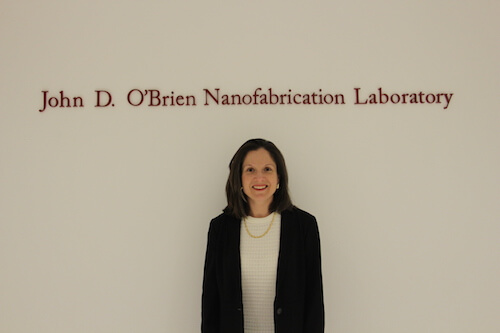
Professor Andrea Armani will oversee the John D. O’Brien Nanofabrication Lab/ Photo Credit: Jane Keranen
Armani is one of the 27 faculty members across campus who already intend to use the space. The optics scientist and engineer will focus on the next iteration of her “tissue squisher glove,” a portable tool that could be used by doctors to assess the aggressiveness of cancer tumors.
Such a world-class facility is critical for innovation and invention. It can provide the space for USC faculty across the university to develop biomedical diagnostics and implantable devices.
Ellis Meng, the Dwight C. and Hildagarde E. Baum Chair, describes it this way: the ability to make, create, and fabricate is the core of what engineers do. Micro- and nanofabrication have become an integral part of the engineer’s toolbox”
Meng said, “The facility allows researchers to develop new micro/nanoscale materials, structures and fabrication processes that are the building blocks for a whole range of micro/nano devices and systems. This can be new inventions or practical structures used to help speed scientific discovery. The impact of such a facility is truly crosscutting and multidisciplinary, etc. We can impact all areas of engineering, science and medicine with the core toolset in the nanofabrication facility.”
“By connecting the nanofab along with all the other ‘maker’ facilities, we now have access to the full spectrum of tools,” Meng said. “This really allows engineers in Viterbi to unleash their creativity. “
This facility, indicated Meng, should enable our faculty to, as Theodore von Karman said, “create the world that never was.”
The Nanofab Lab will allow faculty to develop new cloaking devices, advanced radar, lidar systems or adaptive materials. Particular areas of interest to the USC Viterbi, Dornsife and Keck faculty who will also have labs in the Michelson building might be innovations for cancer diagnosis and treatment and use of stem cells. For example, Ellis Meng could make implantable devices. Other uses might vary. Michelle Povinelli, Associate Professor of Electrical Engineering-Electrophysics and Physics and Astronomy could create quantum photonic devices. Steve Cronin, Professor of Electrical Engineering-Electrophysics, Chemistry, and Physics and Astronomy could create new carbon nanotube transistors. Rehan Kapadia, Assistant Professor of Electrical Engineering-Electrophysics could develop innovations in solar electronics.
As a central user facility, the John D. O’Brien Nanofabrication Lab will be available to faculty throughout the university and will also provide the space for industry collaboration.
The facility has been in the making for over ten years, and Vice Dean Linda Rock worked in tandem with O’Brien to make it reality. In remarks that Rock gave at the dedication ceremony, she noted, “ In many ways the John D. O’Brien Nanofabrication Lab in the basement is a lot like John. Fantastically complex and sophisticated, capable of carrying an enormous load, yet unassuming…a truly supportive place that will enable our faculty and students to perform cutting-edge research for many years to come.”
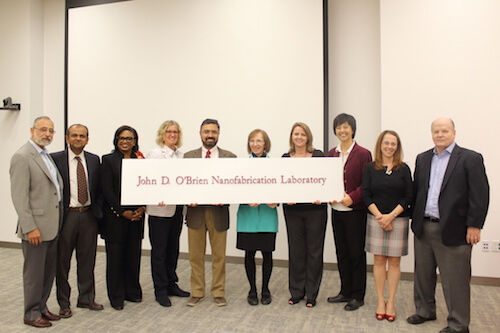
Photo credit: Dylan Cavaz
Speaking at the dedication ceremony, O’Brien’s sister Marcy O’Brien, expressed the following,
“John wanted to help others to have the opportunities and the tools to be the best they could be. He was excited to have this new facility so that the best scientists and engineers could excel and collaborate at USC.”
The Lab, expected to be fully operational in 2018, should fulfill his vision.
About the Michelson Center for Convergent Bioscience
The USC Michelson Center for Convergent Bioscience brings together a diverse network of premier scientists and engineers under one roof. Housed in Michelson Hall, the biggest and most complex building ever constructed on the University Park Campus, the Center will serve as a nucleus for collaborative research.
At the Michelson Center, scientists and engineers from the USC Dornsife College of Letters, Arts and Sciences, USC Viterbi School of Engineering and Keck School of Medicine of USC will work to solve some of the greatest intractable problems of the 21st century in biomedical science, including a fundamentally new understanding of the cell to new approaches for cancer, neurological and cardiovascular disease.
Published on November 13th, 2017
Last updated on November 16th, 2017




